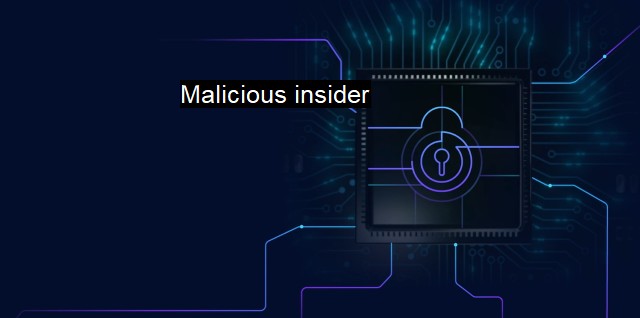What is Malicious insider?
The Rising Risk of Malicious Insiders in the Age of Digital Dependence: Mitigating Hidden Cyber Threats Within Organizations
A malicious insider, within the realm of cyber security and antivirus programs, refers to an individual who possesses authorized access to the critical information and systems of an organization and consciously exploits this access to disrupt operations or release sensitive information. This person can belong to any level of the organization such as an employee, former employee, contractor, third-party vendor, or a partner.It is vital to highlight that an ordinary cyber hack's major roadblock is the initial entry point that must be surpassed to reach the targeted system's built-in defenses. Cyber hackers or attackers need to find vulnerabilities they can exploit to penetrate a system. the position of a malicious insider in a company allows them to bypass these substantial initial defenses completely since they are, by default, within the perimeters.
Malicious insiders carry a significant threat due to the scope and easy access to a range of sensitive information: personal data, customer details, company's financial data, strategic plans, and intellectual properties. With limited measures in place to prevent such internal sources from manipulating this information, organizations face a distinct challenge in preventing insider attacks.
Identifying a potential malicious insider acts as a significant challenge. Since these individuals are legitimate users with authorized access, distinguishing their detrimental actions from regular day-to-day actions stand as a tough task for cyber security defenses. Spotting unusual activity or unnatural behavior can be difficult for many businesses, particularly those larger in size or operations.
Insider threats can be categorized into two main types: the intentional malicious insider that conducts activities to harm their organization intentionally, and the unintentional malicious insider - these individuals may not knowingly cause damage but are manipulated or exploited by external sources. For instance, they might be victims of baiting where a malicious individual tricks them into opening a contaminated email attachment.
Cybersecurity measures designed to tackle external threats may prove ineffective against malicious insiders given that these individuals already possess authorized access to insider resources. This concludes that it's crucial for organizations to incorporate internal threat prevention in their safeguard scheme. One such method can include monitoring employee activity and identifying anomalies, which can be potential indications of an insider threat.
Developing a comprehensive and robust cybersecurity strategy that addresses both external threats and malicious insiders is beneficial. This strategy could encompass employee training, strict access controls, robust data encryption technologies, user activity monitoring, and deploying a secure firewall system. To help in detecting unusual activity, organizations can employ insider threat detection software that uses machine learning to identify patterns that could indicate malicious activity.
It is critical to govern access controls and user privileges as well, ensuring that employees only have access to information entirely necessary for their tasks to minimize opportunities for exploitation. maintaining a log of user activity can further enhance visibility regarding potential vulnerabilities and enable the prompt identification and prevention of any untoward action.
To successfully combat malicious insiders' threats, organizations need to adopt a paradigm shift, accepting the fact that potential threats exist within their team and not just from outside. The proactive inclusion of internal threat detection methodologies within their cybersecurity efforts can assist corporations to go a long way in detecting and combating this risk. For effective prevention from malicious insiders, organizations need to balance their cybersecurity orientations towards both external actors and internal threats from authorized personnel with ill intent.
a malicious insider represents a significant security risk due to their inherent authoritative access to the internal systems of an organization. Through strategic planning and adopting a robust cybersecurity strategy focusing on both external and internal threats, organizations can significantly reduce the threat landscape imposed by malicious insiders.

Malicious insider FAQs
What is a malicious insider in the context of cybersecurity?
A malicious insider is a person who has authorized access to an organization's systems, data, or network and intentionally misuses that access to cause harm to the organization. They can be employees, contractors, or vendors with privileged access to sensitive information.What are some common motivations for a malicious insider to carry out an attack?
Malicious insiders may have a variety of motivations, such as financial gain, revenge, espionage, or personal gratification. They may also be coerced or bribed by external threat actors to carry out an attack.How can organizations prevent malicious insider attacks?
Organizations can prevent malicious insider attacks by implementing security measures such as access controls, monitoring and auditing activity, employee background checks, and security awareness training. It is also important to have incident response plans in place to quickly detect and respond to any potential insider threat.What role do antivirus and other cybersecurity solutions play in protecting against malicious insider attacks?
Antivirus and other cybersecurity solutions can help detect and prevent malicious insider attacks by providing real-time monitoring of network and system activity, identifying unauthorized access, and detecting unusual behavior patterns. They can also help in identifying and blocking malware or other malicious tools used by insiders to carry out their attacks. However, these solutions should be part of a comprehensive security framework that includes other security measures to prevent insider threats.| | A | | | B | | | C | | | D | | | E | | | F | | | G | | | H | | | I | | | J | | | K | | | L | | | M | |
| | N | | | O | | | P | | | Q | | | R | | | S | | | T | | | U | | | V | | | W | | | X | | | Y | | | Z | |
| | 1 | | | 2 | | | 3 | | | 4 | | | 7 | | | 8 | | |||||||